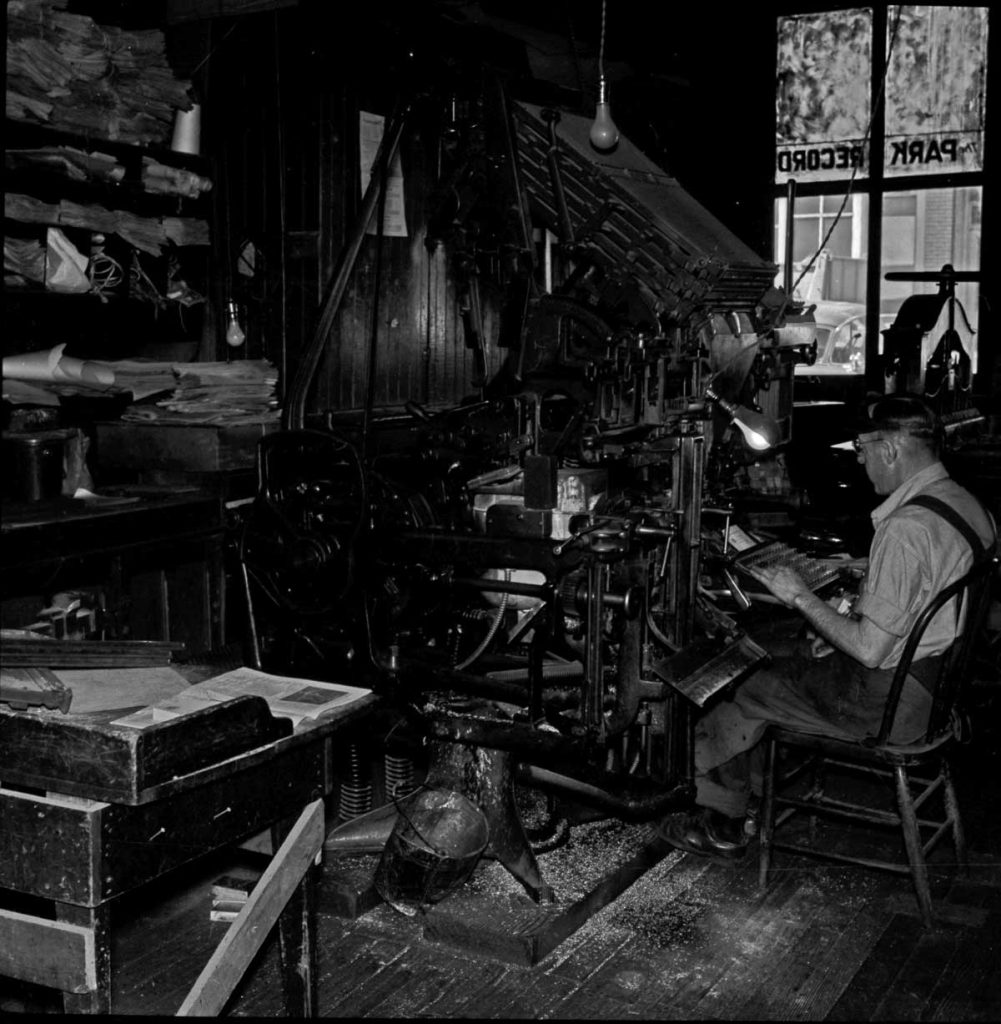The words were not his. But it was his responsibility, for about half a century, to make sure that they appeared in print exactly the way they were written. With just an eighth-grade education, he mastered the Linotype, an ingenious conglomeration of chains and pulleys, turning typed or handwritten articles into columns of “body copy” for the Park Record.
Wilfred “Lynx” Langford was just 15 when editor/publisher Sam Raddon put him on the payroll in August 1917. The oldest of seven children, Lynx had dropped out of school to help support the family after his father’s lungs were attacked by silicosis.
“I started in there sweeping floors, running errands, things like that,” Lynx told me in a 1985 interview. “They used to call you the printer’s devil.”
His salary? “Three dollars a week,” he laughed. “And it was no five-day week. You went to work Monday morning and quit Saturday night.”
Lynx was a quick study. By the early 1920s he had mastered the 90 keys on the Linotype keyboard, assuming arguably the most difficult job in the newspaper’s “backshop.”
If the Linotype operator was on his game, his work usually went unrecognized. But a careless blunder could draw Sam Raddon’s fury. There was the time in July 1933 when the paper described a promising vein of ore in the Mayflower Mine as “20 to 25 feet wide.” It wasn’t true.
“This should have read TWO TO TWO AND A HALF FEET WIDE,” Raddon howled the following week. “This mistake … had the effect of The Record falsely trying to boost a local mining property – something it always studiously tries to avoid.”
In spite of the demands of the job, Lynx found time for play. He was a regular in the softball leagues, hiked the mountains, and skied using a unique form of uphill transportation adopted decades later by the Skier Subway.
In winter Lynx and friends would grab their wooden skis and head up Empire Canyon to the mouth of the Judge Mine tunnel “On Sundays they would have a man train [instead of an ore train] go in with repairmen,” he said. He and his friends would catch a ride 6,600 feet into the mountain.
“Then they would hoist us up the Daly-Judge shaft,” surfacing near the upper end of Deer Valley’s present Empire Express chairlift. “We’d have lunch there, then ski down through the mountains to Park City.”

Credit: Park City Historical Society & Museum, Kendall Webb Collection
In September 1926 Lynx married Madeline Cunningham. They celebrated the arrival of a baby boy at the Miners Hospital the following June. A daughter followed in 1930 and a second son in 1934.
In January 1948, Sam Raddon, the Park Record’s editor and publisher for almost 64 years, died at age 89. His son LaPage “Lee” Raddon assumed the reins of the paper.
However, just eight years later, in January 1956, LaPage died of a heart attack at age 54, leaving the paper in the hands of his widow, Maie Raddon, Lynx, and one other employee.
“Joe Street and I ran the paper from the time Lee died until April [1956], when Mrs. Raddon decided to sell it,” Lynx said. “We didn’t have any experience outside of mechanical work. But people used to write stuff down or telephone it in.”
The new owners of the Park Record were Louise and H.C. “Mac” McConaughy, who already produced two other area weekly papers out of a printshop in Morgan.
“They come up one Sunday with a big truck to move the Linotype out to Morgan,” Lynx said.
“[Mac] McConaughy was short of help so he said, ‘You want a job?’ And I said, ‘Sure.’ So I went to Morgan Monday morning with the same old Linotype and I worked in Morgan for [another] 20 years.” Lynx moved his family to Morgan but kept his Park City house, which still stands today at 602 Park Avenue.
In Morgan, Lynx was the McConaughys’ strongest link with Park City. “I could … listen for hours [to] the stories he tells of his still much-loved hometown [of] Park City,” Louise McConaughy wrote in 1966.
In March 1967 Lynx’s duties changed when the McConaughys bought a rudimentary computerized system to set columns of type for their newspapers. The Linotype was relegated to specialty print jobs.
Then, in September 1976, the McConaughys, struggling financially, sold their three newspapers to Richard and Susan Buys, the owners of the Wasatch Wave, and production was moved to Heber City. The old Linotype was scrapped and Lynx was out of a job for the first time since 1917. He lived another year in Morgan, then moved to Salt Lake City, where he died in 1988.
A lot of water has gone down Poison Creek since 1976, and the Park Record has changed hands several times. But Lynx’s 59 years of service to the paper remains second only to the legendary Sam Raddon.